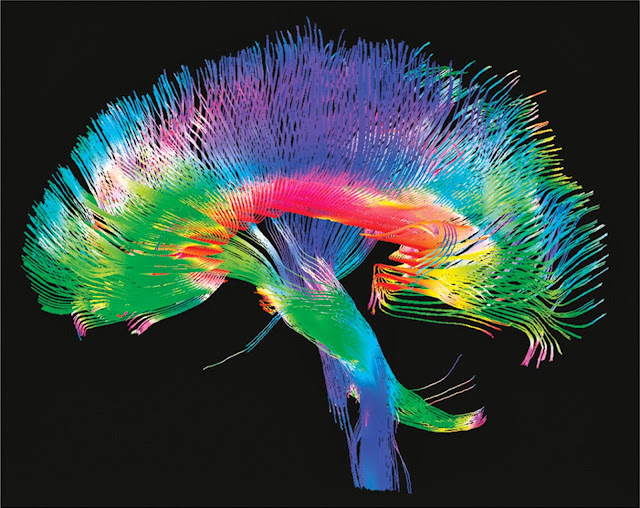Syncopated Ghost Whispers Haunt Your Internal Web
Above, you see an early depiction of the "long distance network" of the brain, connecting different brain centres with each other. The complex visualisation was compiled using information obtained from the study of the macaque brain.
The Human Connectome Project is hard at work producing images such as this, using an MRI technique known as diffusion tensor imaging.
With 100 billion neurons, each with around 10,000 connections, mapping the human brain will be no easy feat, and charting every single connection could take decades. The HCP will tackle the lowest hanging fruit first: charting the major highways between different brain regions, and showing how these connections vary between individuals. To do this they will combine several imaging tools including something called diffusion MRI, which maps the structure of the white matter that insulates the "wires" of the brain, and also resting-state MRI, which measures how brain regions oscillate in unison as a result of shared connections. _NewScientist
Cortical parcellations (PDF) such as the above, use another MRI technique. This method of brain visualisation separates different cortical domains which serve particular functions.
These brain images are presented for purposes of orientation and grounding. They may help to picture the various nodes and connections presented in the abstracted images and schematics.
Above, you see some of the brain areas involved in three important brain networks: Default Mode, Salience, and Central Executive. When viewing such fMRI "activation" images, it is helpful to mentally superimpose the connections between the activated brain centres. More on the three pictured networks:
The default mode (DMN) or default brain network (shown in blue) is what your brain does when not engaged in specific tasks. It is the busy or active part of your brain when you are mentally passive. According to Bresslor and Brennon the “DMN is seen to collectively comprise an integrated system for autobiographical, self-monitoring and social cognitive functions.” It has also been characterized as responsible for REST (rapid episodic spontaneous thinking). In other words, this is the spontaneous mind wandering and internal self-talk and thinking we engage in when not working on a specific task or, when completing a task that is so automatized (e.g., driving a car) that our mind starts to wander and generate spontaneous thoughts.We have talked about the default mode network previously, and will devote future time to the integration of various overlapping -- as well as mutually exclusive -- networks.
...The salience network (shown in yellow) is a controllor or network switcher. It monitors information from within (internal input) and from the external world arounding us, which is constantly bombarding us with information. Think of the salience network as the air traffic controllor of the brain. Its job is to scan all information bombarding us from the outside world and also that from within our own brains. This controller decides which information is most urgent, task relevant, and which should receive priority in the que of sending brain signals to areas of the brain for processing.
...Finally, the central-executive network (CEN; shown in red) “is engaged in higher-order cognitive and attentional control.” In other words, when you must engage your concious brain to work on a problem, place information in your working memory as you think, focus your attention on a task or problem, etc., you are “thinking” and must focus your controlled attention. _BrainClockBlog
Now, we are getting close to the "brass tacks" of how separate brain nodes communicate synchronously with each other via the connectome. The brain functions as a hierarchical network, and depends upon analogous -- but different -- mechanisms of ensemble activity at different levels of the hierarchy.
... when multiple neurons spread all over the brain are tuned in to a specific pattern of electrical activity at a specific frequency, then whenever that global activity pattern occurs, those neurons can act as a coordinated assembly."One of the many things that makes understanding the brain so difficult, is the fact that so many things are happening all at once, on so many different levels -- both in serial and parallel format. Almost all of the things that go on in the brain occur on the unconscious or subconscious levels. Consciousness, as we know it, is something of an over-rated evolutionary accident.
The researchers pointed out that this mechanism of cell assembly formation via oscillatory phase coupling is selective. Two neurons that are sensitive to different frequencies or to different spatial coupling patterns will exhibit independent activity, no matter how close they are spatially, and will not be part of the same assembly. Conversely, two neurons that prefer a similar pattern of coupling will exhibit similar spiking activity over time, even if they are widely separated or in different brain areas. _SD
Video via Kevin at Brain Clock Blog
Finally, watch ghostly whispers moving through the human brain as it is put through its paces.
More information on brain networks at The Brain Clock Blog: The brain as a set of networks: Fine tunning your networks
Labels: brain imaging, brain networks, brain oscillations, connectome








2 Comments:
Merry Christmas, al Fin. Thanks for making me smarter each day.
Merry Christmas, BP.
You know very well that I (we) cannot make anyone anything. The best I (we) can do is to point out a few possibilities.
It is a pleasure sharing the blogosphere with you.
Post a Comment
“During times of universal deceit, telling the truth becomes a revolutionary act” _George Orwell
<< Home